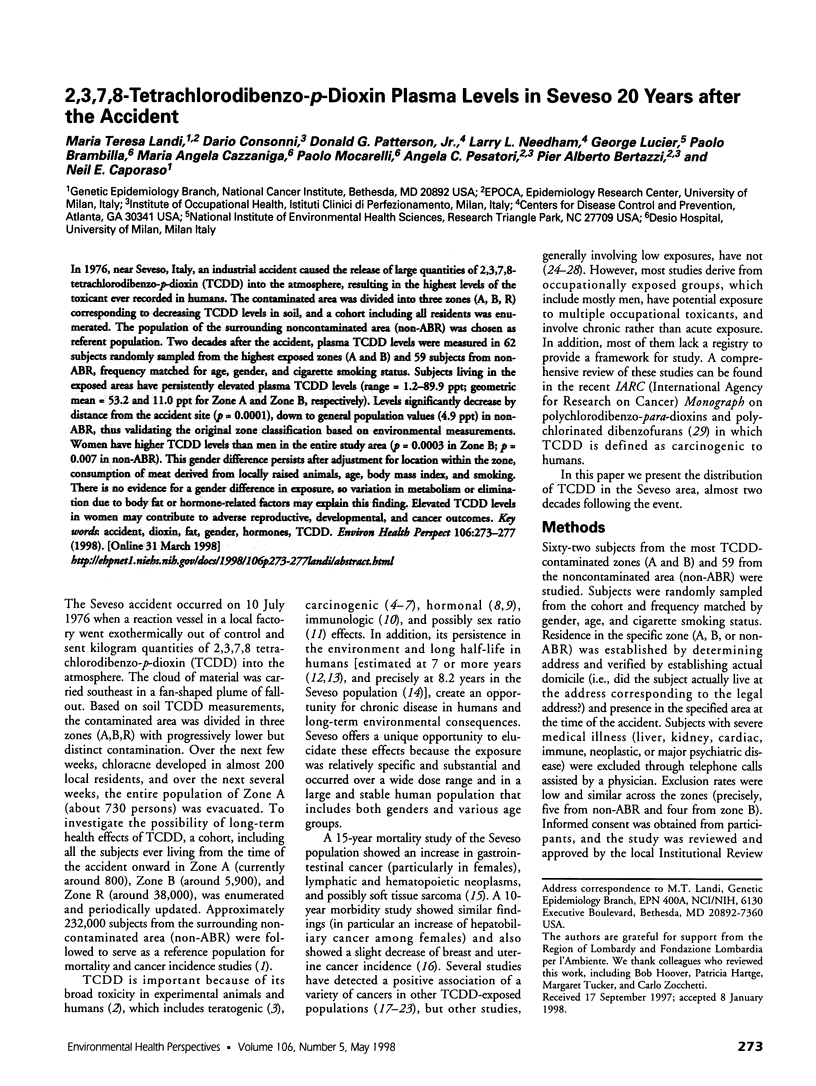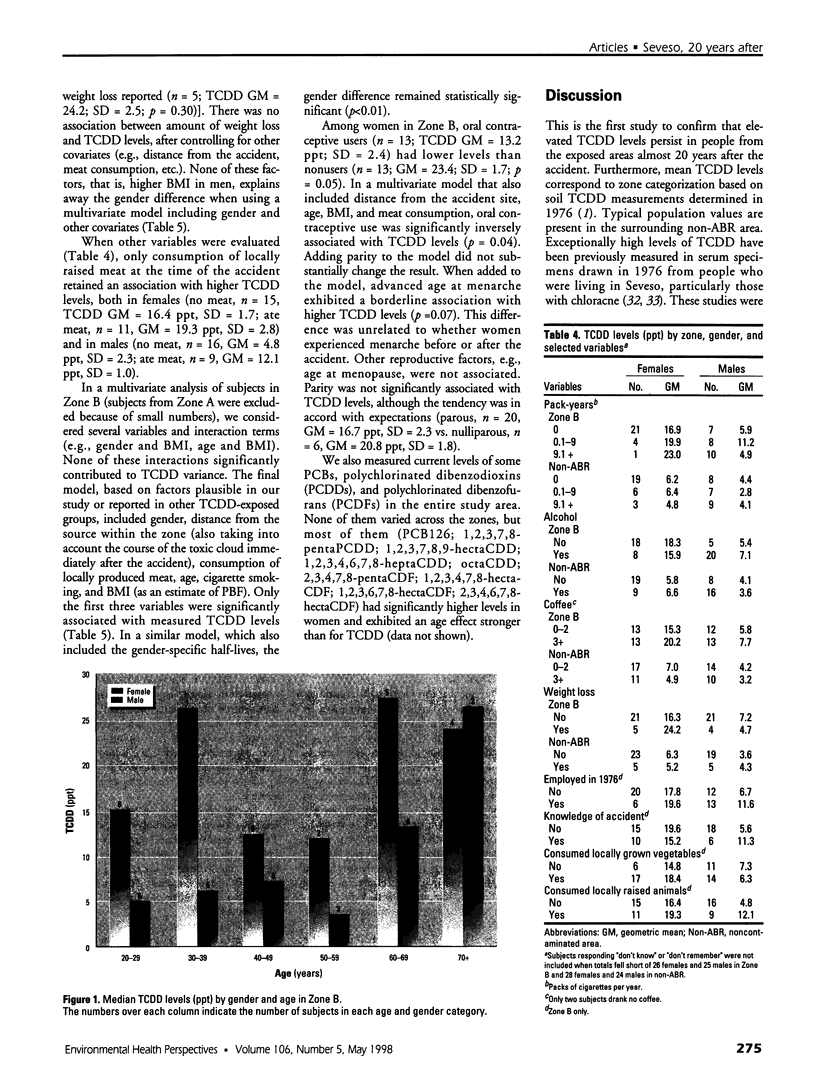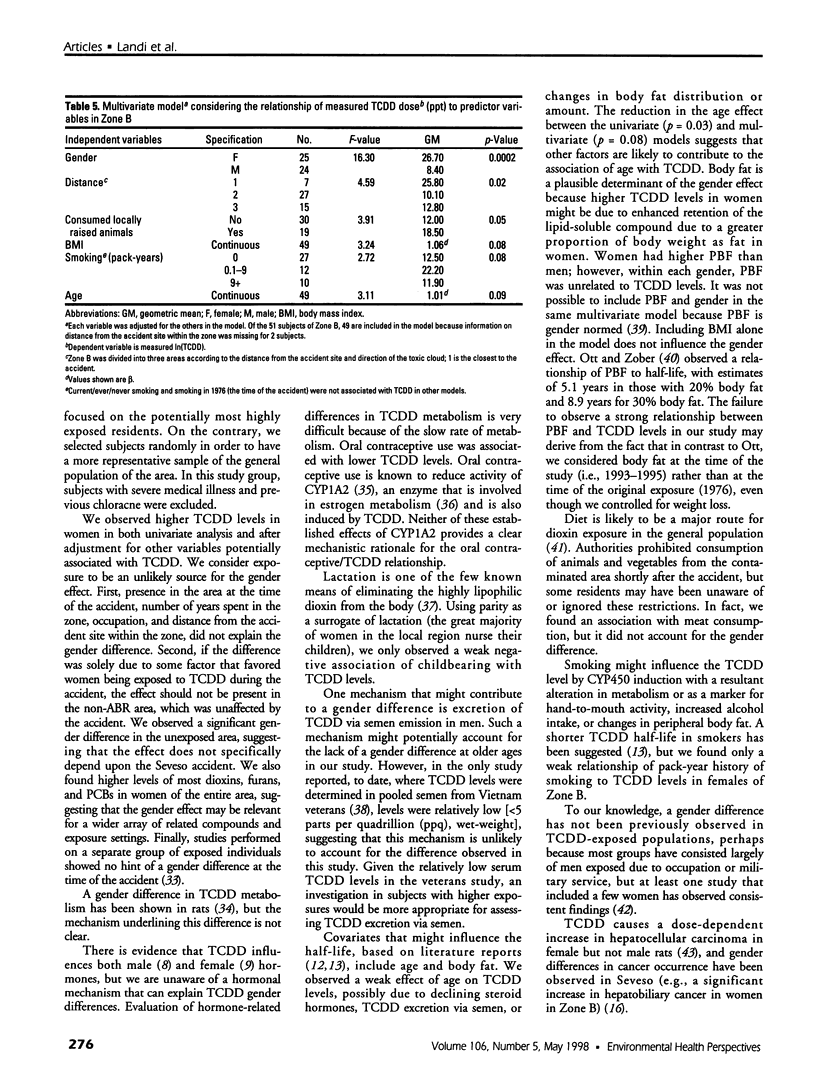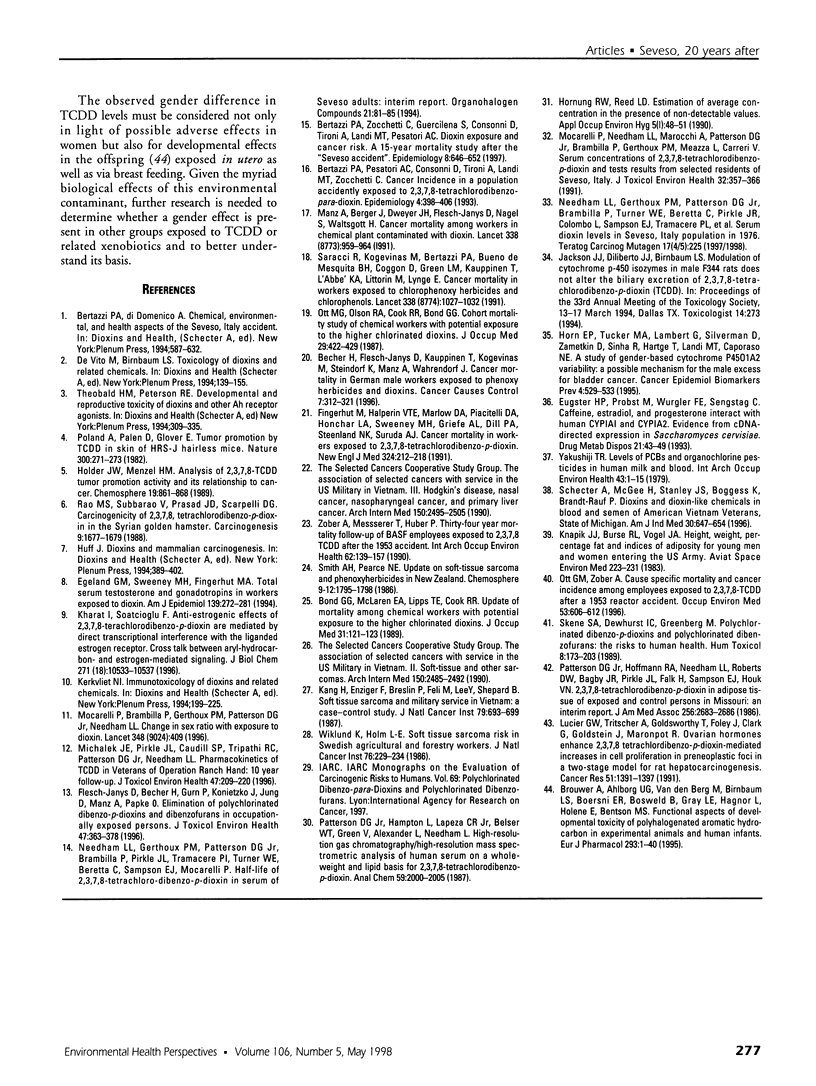Abstract
In 1976, near Seveso, Italy, an industrial accident caused the release of large quantities of 2,3,7,8-tetrachlorodibenzo-p-dioxin (TCDD) into the atmosphere, resulting in the highest levels of the toxicant ever recorded in humans. The contaminated area was divided into three zones (A, B, R) corresponding to decreasing TCDD levels in soil, and cohort including all residents was enumerated. The population of the surrounding noncontaminated area (non-ABR) was chosen as referent population. Two decades after the accident. plasma TCDD levels were measured in 62 subjects randomly sampled from the highest exposed zones (A and B) and 59 subjects from non-ABR, frequency matched for age, gender, and cigarette smoking status. Subjects living in the exposed areas have persistently elevated plasma TCDD levels (range = 1.2-89.9 ppt; geometric mean = 53.2 and 11.0 ppt for Zone A and Zone B, respectively). Levels significantly decrease by distance from the accident site (p = 0.0001), down to general population values (4.9 ppt) in non-ABR, thus validating the original zone classification based on environmental measurements. Women have higher TCDD levels than men in the entire study area (p = 0.0003 in Zone B; p = 0.007 in non-ABR). This gender difference persists after adjustment for location within the zone, consumption of meat derived from locally raised animals, age, body mass index, and smoking. There is no evidence for a gender difference in exposure, so variation in metabolism or elimination due to body fat or hormone-related factors may explain this finding. Elevated TCDD levels in women may contribute to adverse reproductive, developmental, and cancer outcomes.
Full text
PDF




Images in this article
Selected References
These references are in PubMed. This may not be the complete list of references from this article.
- Becher H., Flesch-Janys D., Kauppinen T., Kogevinas M., Steindorf K., Manz A., Wahrendorf J. Cancer mortality in German male workers exposed to phenoxy herbicides and dioxins. Cancer Causes Control. 1996 May;7(3):312–321. doi: 10.1007/BF00052936. [DOI] [PubMed] [Google Scholar]
- Bertazzi A., Pesatori A. C., Consonni D., Tironi A., Landi M. T., Zocchetti C. Cancer incidence in a population accidentally exposed to 2,3,7,8-tetrachlorodibenzo-para-dioxin. Epidemiology. 1993 Sep;4(5):398–406. doi: 10.1097/00001648-199309000-00004. [DOI] [PubMed] [Google Scholar]
- Bertazzi P. A., Zocchetti C., Guercilena S., Consonni D., Tironi A., Landi M. T., Pesatori A. C. Dioxin exposure and cancer risk: a 15-year mortality study after the "Seveso accident". Epidemiology. 1997 Nov;8(6):646–652. [PubMed] [Google Scholar]
- Bond G. G., McLaren E. A., Lipps T. E., Cook R. R. Update of mortality among chemical workers with potential exposure to the higher chlorinated dioxins. J Occup Med. 1989 Feb;31(2):121–123. [PubMed] [Google Scholar]
- Brouwer A., Ahlborg U. G., Van den Berg M., Birnbaum L. S., Boersma E. R., Bosveld B., Denison M. S., Gray L. E., Hagmar L., Holene E. Functional aspects of developmental toxicity of polyhalogenated aromatic hydrocarbons in experimental animals and human infants. Eur J Pharmacol. 1995 May 26;293(1):1–40. doi: 10.1016/0926-6917(95)90015-2. [DOI] [PubMed] [Google Scholar]
- Egeland G. M., Sweeney M. H., Fingerhut M. A., Wille K. K., Schnorr T. M., Halperin W. E. Total serum testosterone and gonadotropins in workers exposed to dioxin. Am J Epidemiol. 1994 Feb 1;139(3):272–281. doi: 10.1093/oxfordjournals.aje.a116994. [DOI] [PubMed] [Google Scholar]
- Eugster H. P., Probst M., Würgler F. E., Sengstag C. Caffeine, estradiol, and progesterone interact with human CYP1A1 and CYP1A2. Evidence from cDNA-directed expression in Saccharomyces cerevisiae. Drug Metab Dispos. 1993 Jan-Feb;21(1):43–49. [PubMed] [Google Scholar]
- Fingerhut M. A., Halperin W. E., Marlow D. A., Piacitelli L. A., Honchar P. A., Sweeney M. H., Greife A. L., Dill P. A., Steenland K., Suruda A. J. Cancer mortality in workers exposed to 2,3,7,8-tetrachlorodibenzo-p-dioxin. N Engl J Med. 1991 Jan 24;324(4):212–218. doi: 10.1056/NEJM199101243240402. [DOI] [PubMed] [Google Scholar]
- Flesch-Janys D., Becher H., Gurn P., Jung D., Konietzko J., Manz A., Päpke O. Elimination of polychlorinated dibenzo-p-dioxins and dibenzofurans in occupationally exposed persons. J Toxicol Environ Health. 1996 Mar;47(4):363–378. doi: 10.1080/009841096161708. [DOI] [PubMed] [Google Scholar]
- Horn E. P., Tucker M. A., Lambert G., Silverman D., Zametkin D., Sinha R., Hartge T., Landi M. T., Caporaso N. E. A study of gender-based cytochrome P4501A2 variability: a possible mechanism for the male excess of bladder cancer. Cancer Epidemiol Biomarkers Prev. 1995 Jul-Aug;4(5):529–533. [PubMed] [Google Scholar]
- Kang H., Enzinger F. M., Breslin P., Feil M., Lee Y., Shepard B., Enziger F. Soft tissue sarcoma and military service in Vietnam: a case-control study. J Natl Cancer Inst. 1987 Oct;79(4):693–699. [PubMed] [Google Scholar]
- Kharat I., Saatcioglu F. Antiestrogenic effects of 2,3,7,8-tetrachlorodibenzo-p-dioxin are mediated by direct transcriptional interference with the liganded estrogen receptor. Cross-talk between aryl hydrocarbon- and estrogen-mediated signaling. J Biol Chem. 1996 May 3;271(18):10533–10537. doi: 10.1074/jbc.271.18.10533. [DOI] [PubMed] [Google Scholar]
- Lucier G. W., Tritscher A., Goldsworthy T., Foley J., Clark G., Goldstein J., Maronpot R. Ovarian hormones enhance 2,3,7,8-tetrachlorodibenzo-p-dioxin-mediated increases in cell proliferation and preneoplastic foci in a two-stage model for rat hepatocarcinogenesis. Cancer Res. 1991 Mar 1;51(5):1391–1397. [PubMed] [Google Scholar]
- Lüscher N. J., Tschopp H. M. Lokale Spätfolgen nach brusterhaltender Therapie des Mammakarzinoms: Problemfälle und ihre Korrekturmöglichkeiten. Helv Chir Acta. 1989 Apr;55(6):861–868. [PubMed] [Google Scholar]
- Manz A., Berger J., Dwyer J. H., Flesch-Janys D., Nagel S., Waltsgott H. Cancer mortality among workers in chemical plant contaminated with dioxin. Lancet. 1991 Oct 19;338(8773):959–964. doi: 10.1016/0140-6736(91)91835-i. [DOI] [PubMed] [Google Scholar]
- Michalek J. E., Pirkle J. L., Caudill S. P., Tripathi R. C., Patterson D. G., Jr, Needham L. L. Pharmacokinetics of TCDD in veterans of Operation Ranch Hand: 10-year follow-up. J Toxicol Environ Health. 1996 Feb 23;47(3):209–220. doi: 10.1080/009841096161744. [DOI] [PubMed] [Google Scholar]
- Mocarelli P., Brambilla P., Gerthoux P. M., Patterson D. G., Jr, Needham L. L. Change in sex ratio with exposure to dioxin. Lancet. 1996 Aug 10;348(9024):409–409. doi: 10.1016/s0140-6736(05)65030-1. [DOI] [PubMed] [Google Scholar]
- Mocarelli P., Needham L. L., Marocchi A., Patterson D. G., Jr, Brambilla P., Gerthoux P. M., Meazza L., Carreri V. Serum concentrations of 2,3,7,8-tetrachlorodibenzo-p-dioxin and test results from selected residents of Seveso, Italy. J Toxicol Environ Health. 1991 Apr;32(4):357–366. doi: 10.1080/15287399109531490. [DOI] [PubMed] [Google Scholar]
- Needham L. L., Gerthoux P. M., Patterson D. G., Jr, Brambilla P., Turner W. E., Beretta C., Pirkle J. L., Colombo L., Sampson E. J., Tramacere P. L. Serum dioxin levels in Seveso, Italy, population in 1976. Teratog Carcinog Mutagen. 1997;17(4-5):225–240. [PubMed] [Google Scholar]
- Ott M. G., Olson R. A., Cook R. R., Bond G. G. Cohort mortality study of chemical workers with potential exposure to the higher chlorinated dioxins. J Occup Med. 1987 May;29(5):422–429. [PubMed] [Google Scholar]
- Ott M. G., Zober A. Cause specific mortality and cancer incidence among employees exposed to 2,3,7,8-TCDD after a 1953 reactor accident. Occup Environ Med. 1996 Sep;53(9):606–612. doi: 10.1136/oem.53.9.606. [DOI] [PMC free article] [PubMed] [Google Scholar]
- Patterson D. G., Jr, Hoffman R. E., Needham L. L., Roberts D. W., Bagby J. R., Pirkle J. L., Falk H., Sampson E. J., Houk V. N. 2,3,7,8-Tetrachlorodibenzo-p-dioxin levels in adipose tissue of exposed and control persons in Missouri. An interim report. JAMA. 1986 Nov 21;256(19):2683–2686. [PubMed] [Google Scholar]
- Poland A., Palen D., Glover E. Tumour promotion by TCDD in skin of HRS/J hairless mice. Nature. 1982 Nov 18;300(5889):271–273. doi: 10.1038/300271a0. [DOI] [PubMed] [Google Scholar]
- Rao M. S., Subbarao V., Prasad J. D., Scarpelli D. G. Carcinogenicity of 2,3,7,8-tetrachlorodibenzo-p-dioxin in the Syrian golden hamster. Carcinogenesis. 1988 Sep;9(9):1677–1679. doi: 10.1093/carcin/9.9.1677. [DOI] [PubMed] [Google Scholar]
- Saracci R., Kogevinas M., Bertazzi P. A., Bueno de Mesquita B. H., Coggon D., Green L. M., Kauppinen T., L'Abbé K. A., Littorin M., Lynge E. Cancer mortality in workers exposed to chlorophenoxy herbicides and chlorophenols. Lancet. 1991 Oct 26;338(8774):1027–1032. doi: 10.1016/0140-6736(91)91898-5. [DOI] [PubMed] [Google Scholar]
- Schecter A., McGee H., Stanley J. S., Boggess K., Brandt-Rauf P. Dioxins and dioxin-like chemicals in blood and semen of American Vietnam veterans from the state of Michigan. Am J Ind Med. 1996 Dec;30(6):647–654. doi: 10.1002/(SICI)1097-0274(199612)30:6<647::AID-AJIM1>3.0.CO;2-O. [DOI] [PubMed] [Google Scholar]
- Skene S. A., Dewhurst I. C., Greenberg M. Polychlorinated dibenzo-p-dioxins and polychlorinated dibenzofurans: the risks to human health. A review. Hum Toxicol. 1989 May;8(3):173–203. doi: 10.1177/096032718900800301. [DOI] [PubMed] [Google Scholar]
- Wiklund K., Holm L. E. Soft tissue sarcoma risk in Swedish agricultural and forestry workers. J Natl Cancer Inst. 1986 Feb;76(2):229–234. [PubMed] [Google Scholar]
- Yakushiji T., Watanabe I., Kuwabara K., Yoshida S., Koyama K., Kunita N. Levels of polychlorinated biphenyls (PCBs) and organochlorine pesticides in human milk and blood collected in Osaka Prefecture from 1972 to 1977. Int Arch Occup Environ Health. 1979 Mar 7;43(1):1–15. doi: 10.1007/BF00454276. [DOI] [PubMed] [Google Scholar]
- Zober A., Messerer P., Huber P. Thirty-four-year mortality follow-up of BASF employees exposed to 2,3,7,8-TCDD after the 1953 accident. Int Arch Occup Environ Health. 1990;62(2):139–157. doi: 10.1007/BF00383591. [DOI] [PubMed] [Google Scholar]



